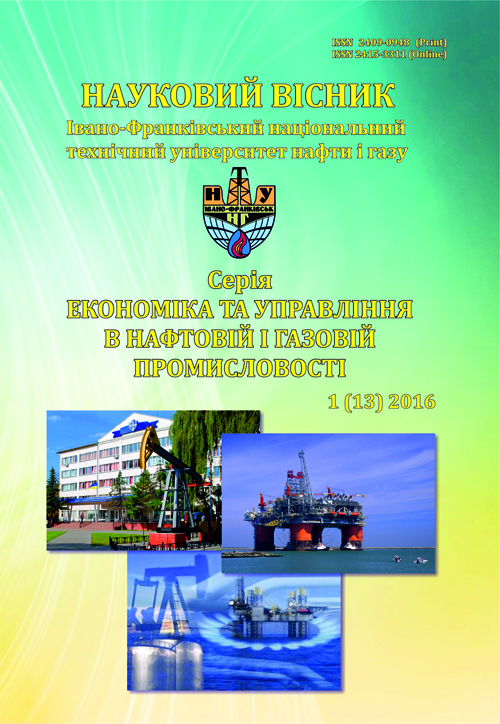Quantitative Evaluation of Competitive Edges of Enterprise
Keywords:
competitive advantage, quantitate estimate, analysis, marketing activity of enterprises.Abstract
Methodological approaches to the quantitative estimate of competitive advantages of an
enterprise are characterized and substantiated. Competitive advantages are one of the most important
categories of market economy and the main purpose and result of an enterprise’s business performance.
This research is aimed at further development of the system of managing competitive advantages of an
enterprise and its competitiveness. Such estimate provides an opportunity to identify the strengths and
weaknesses of an enterprise, to reveal its hidden potential and, accordingly, to improve its competitive
strategy.Today, domestic practice has no generally accepted methodology of the determination and estimate
of competitive advantages of an enterprise. In general, all existing estimate methods are based on the
diagnostics of the competitive situation on the market, the analysis of the competitive position,
competitive potential and the competitiveness level of an enterprise and are aimed at the development and
implementation of an effective competitive strategy. The following issues need further studies: the
ordering of notions and categories of the competitive advantage theory, the reasoning of methods of
competitive advantages analysis, the choice of estimate indices, the specification of the list and sequence
of stages of managing competitive advantages, working out the procedures of the introduction of the
technology and tools of the formation and development of competitive advantages etc.
The usage of certain methods depends on the peculiarities of an enterprise, its industry sector, the
market, consumers, information base and many other factors.
References
Бринзя, Д. М. Мозоль //Вісник Волинського інституту економіки та менеджменту. – 2013. − №6.–
С. 16 – 25.
2. Горєлов Д. О. Стратегія підприємства: навч.-метод. посіб. [для студ. вищ. навч. закл.] / Д.
О. Горєлов, С. Ф. Большенко. – Харків : Вид-во ХНАДУ, 2010. – 133 с.
3. Гусєва О. В. Доцільність застосування матричних методів для оцінки
конкурентоспроможності малих готелів / О. В. Гусєва // Вісник Волинського інституту економіки
та менеджменту. – 2013. − №6. − С. 28 – 34.
4. Должанський І. З. Конкурентоспроможність підприємства / І. З. Должанський, Т. О.
Загорна.– К. : Центр навчальної літератури, 2002. – 282 с.
5. Маслак О. І. Визначення рівня конкурентної переваги машинобудівного підприємства на
засадах забезпечення розвитку його економічного потенціалу / О. І. Маслак, Л. А. Квятковська, О.
О. Безручко // Ефективна економіка. – 2014. – № 7. – С. 22 – 28.
6. Портер М. Е. Конкурентная стратегия: методика анализа отраслей и конкурентов / М. Е.
Портер; пер. с англ. И. Минервина.– 2-е изд. – М. : АльпинаБизнес Букс, 2006. – 452 с.
7. Портер М. Е. Стратегія конкуренції /М. Е. Портер ; пер. з англ. – К. : Основи, 1998. – 390 с.
8. Шершньова З. Є. Стратегічне управління: підручник / З. Є. Шершньова. – 2-ге вид.,
перероб. і доп. – К. : КНЕУ, 2004. – 699 с.
9. SWOT-аналіз – основа формування маркетингових стратегій: навчальний посібник / За ред.
Л. В. Балабанової. – 2-ге вид., випр. і доп. – К. : Знання, 2005.–301 с.
Downloads
Published
How to Cite
Issue
Section
License
Copyright and Licensing Terms
Copyright Statement
The authors who publish in the journal accept the following conditions:
- The authors retain the copyright and grant the journal the right of first publication, licensed with Creative CommonsCC BY-NC-SA , which permits other people to remix, transform, and build upon the material and use the material for non-commercial purposes, give appropriate credit and distribute the contributions under the same license as the original.
- The authors can conclude additional agreements on the non-exclusive distribution of the journal’s published version of the work (for example, publication of the work in electronic repositories) with an acknowledgment of its initial publication in this journal.
- The authors can upload the published articles on the Internet (for example, in electronic repositories or on web-sites), as it will stimulate fruitful scholarly discussions and increase the citation rates of the published articles.


1.png)


1.png)





